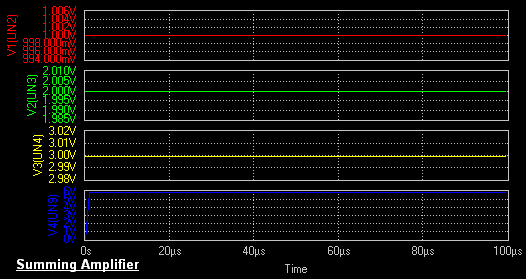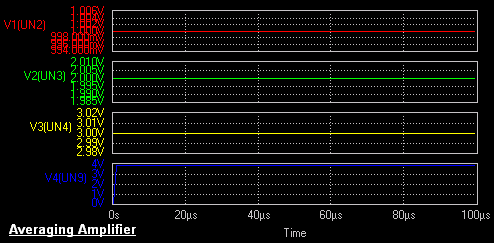741 Non-Inverting Amplifiers
Aim
To design and simulate Summing and Averaging Amplifier circuits using
741.
Components
|
Name
|
EDWin Components Used |
Description |
Number of components
required |
| RES |
RC05 |
Resistor |
6 |
| COMPARATOR |
LM358 |
Comparator |
1 |
| VDC |
VDC |
Dc voltage source |
5 |
| GND |
SPL0 |
Ground |
7* |
Theory
An operational amplifier is a direct coupled
high gain amplifier consisting of one or more differential amplifiers and usually followed
by a level translator and an output stage which is
usually a push-pull or push-pull complementary symmetry pair. An operational amplifier can be used to
amplify ac as well as dc input signals and was originally designed
for computing such mathematical functions as addition, subtraction, multiplication
and integration.
An opamp can be configured in
either the inverting or in the non-inverting mode. The circuit shown
below is called a non-inverting amplifier, since the
input voltage sources and resistors are connected to the non-inverting terminal of the
op-amp. The circuit can be used either as a summing or an
averaging amplifier through the selection of appropriate values of resistors, R1
and RF. The input resistance RiF of the non-inverting amplifier is very large and is given
by

In order to verify the
functions of the circuit, the expression for the output voltage can be
obtained as follows. Applying the superposition theorem,
the voltage
V1 at
the non-inverting terminal is


Hence the output voltage Vo is


Summing Amplifier
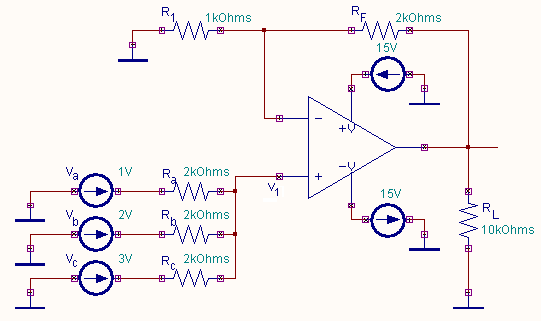
The Summing Amplifier produced using 741 is the circuit that sums up
all the input voltages. As evident from equation 4 if the gain  is equal to the number of inputs, the output voltage becomes equal to the sum of all input
voltages. That is, if
is equal to the number of inputs, the output voltage becomes equal to the sum of all input
voltages. That is, if  , then
, then  .
.
Hence the circuit is called a non-inverting summing amplifier.
Averaging Amplifier
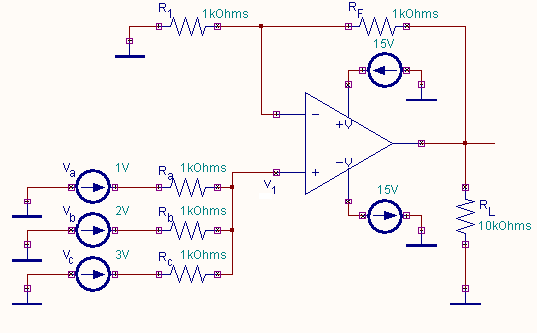
The output of the non-inverting amplifier as obtained from
equation 4 is equal to the average of all the input voltages times the
gain of the circuit,  hence the name averaging amplifier. Depending
on the application requirement the gain
hence the name averaging amplifier. Depending
on the application requirement the gain  can be set to a specific value. If the gain is 1 then the output voltage will be equal to
the average of all input voltages. One special feature to be noted is that
the non-
inverting input voltage V1 is the
average of all the inputs.
can be set to a specific value. If the gain is 1 then the output voltage will be equal to
the average of all input voltages. One special feature to be noted is that
the non-
inverting input voltage V1 is the
average of all the inputs.
Procedure
EDWinXP-> Schematic Editor: The circuit diagram is drawn by loading components
from the library. Wiring and proper net assignment has been made.
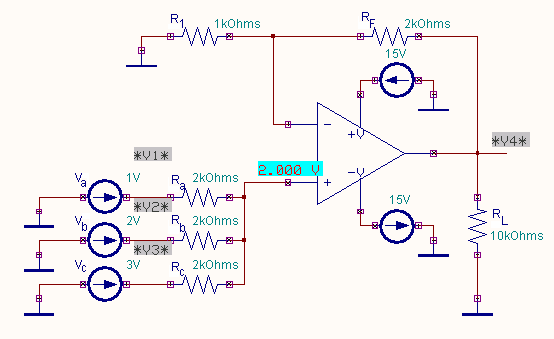
The values are assigned for relevant components.
EDWinXP-> Mixed Mode Simulator: The circuit is preprocessed. Waveform markers are placed in
input and output of the circuit. GND net is set as reference net. The Transient Analysis parameters have been
set. The Transient Analysis is executed and output waveform is observed in
the Waveform Viewer.
Result
The output waveform may be observed in the waveform viewer.
